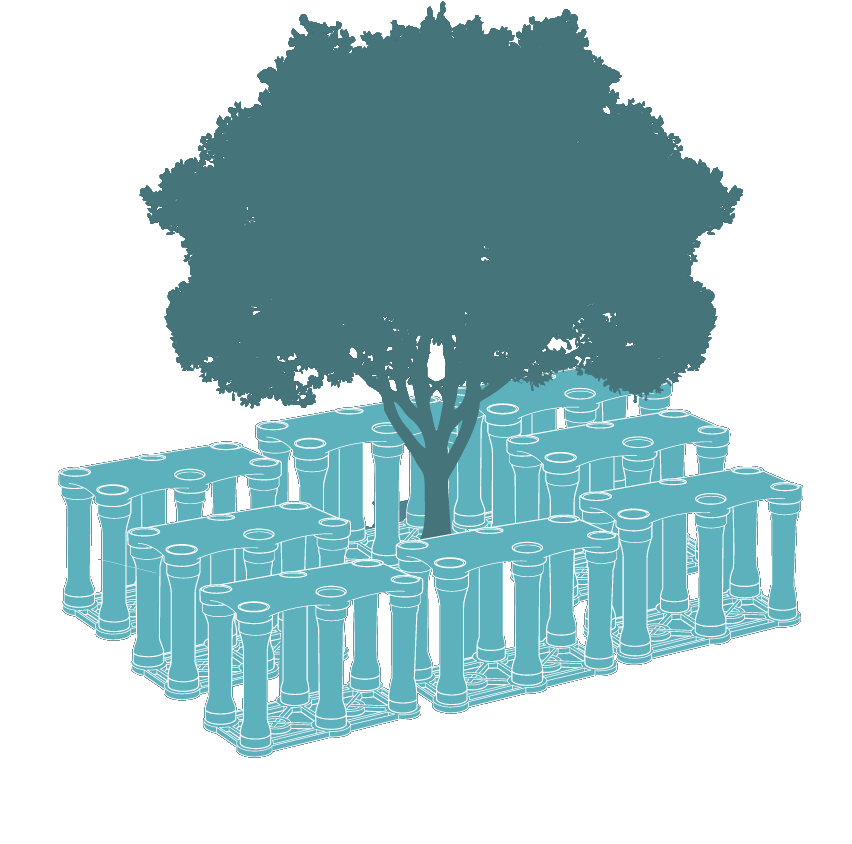Urban Soils
Soil provides five essential functions in an ecosystem: water regulation, buffering against pollutants and pathogens, sustaining plant and animal life, cycling nutrients through the ecosystem, and providing physical stability.
It consists of five components: nutrients, minerals, water, gases, and liquids. Over time, solid rock formations breakdown into smaller and smaller pieces and combine with soil organic matter (SOM) such as fallen leaves, dead creatures, living and dead microorganisms, animal waste, and well composted organic matter, which becomes the ground we walk on.
Soil is alive!
A common misconception about soil is that it is a static part of an ecosystem. In fact, while it may sound like something out of a sci-fi movie, soil is alive! In one cubic foot of soil there may be 2 trillion bacteria, 3 miles of fungal hyphae, 4 million protozoa, 30 thousand nematodes and hundreds of microarthropods (DuPont et al.) The microorganisms in soil play a critical role in the nutrient cycle, or the recycling of organic matter by breaking it down into more basic nutrients, minerals, liquids and gases, which can then be absorbed again by other organisms and plants.
Microorganisms are also critical for creating and maintaining healthy soil structure. What soil structure refers to is the arrangement of the soil particles which influences how water and gases move through it, making it more or less suitable for certain plants. Another common misconception about soil is that it is made up of only solid particles. In reality, ideal soil is 50% solid particles (made up of minerals and SOM) and 50% water and air. For trees to grow, their roots need to be able to process sugars into energy, a process that requires cellular respiration. This process is what makes it possible for a plant’s cells to intake oxygen and output water and CO2. The human equivalent to this would be when we sweat while exercising (using energy). This is why pockets of air and water in soil are required for roots to process sugars into energy.
Soil Compaction and Tree Health
Soil compaction occurs when soil is compressed either over time, such as by foot traffic, or by vehicles or machinery. It is a factor that affects soil health negatively, degrading soil structure in urban areas. Soil compaction squeezes the solid particles together, pushing out pockets of air and water, making it especially difficult for trees and other plants to survive with limited access to nutrients, oxygen, water, and space to grow.
But, to have green space in our urban areas–in parks, right-of-ways, and as building foundations–the soil must be compacted to some degree to provide reliable stability for regular use. Imagine if you were walking along a park path only to find the ground give way, or imagine the damage buildings would sustain on an uncompacted foundation where the ground would compress underneath them over time. The typical solution to this issue is structural soil.
Structural soil is a mixture of rock and dirt that can be compacted to a degree that it becomes structurally sound as a foundation for sidewalks or road ways. As such, it is mostly rock, making it hard for tree roots to find nutrients, have access to oxygen, and to uptake water, as the soil drains so quickly.
Recently companies have been developing alternative methods for creating structurally sound soils for building called soil cells, that also leave space for tree and plant growth.
Soil cells are structures of columns and beams made of plastic or fiberglass which are installed below ground to support paved areas while retaining space of minimally compacted soil for tree roots to grow. Comparatively, trees planted in spaces that use soil cells instead of structural soil grow taller, have bigger canopies, are able to filter more stormwater pollution, and live longer. Soil cells are also comparatively more sustainable to produce than structural soil even though they are made of plastic, because the energy needed to mine, crush, and ship the structural soil is immense.
Soil cells can also be filled with local recycled soil, instead of needing soil shipped from another area. The innovation of soil cells will allow our urban trees, especially those growing in areas with a lot of concrete, to live longer, healthier, and to provide more benefits to the surrounding environment throughout their lifespans.
While soil cells are typically only used in commercial building projects, you can make sure your trees at home are healthy by providing them with the right kind of soil for their species, limiting foot traffic and driving near trees, adding mulch or compost to the soil, and planting a variety of plants. For more information on healthy soil management see this guide.




